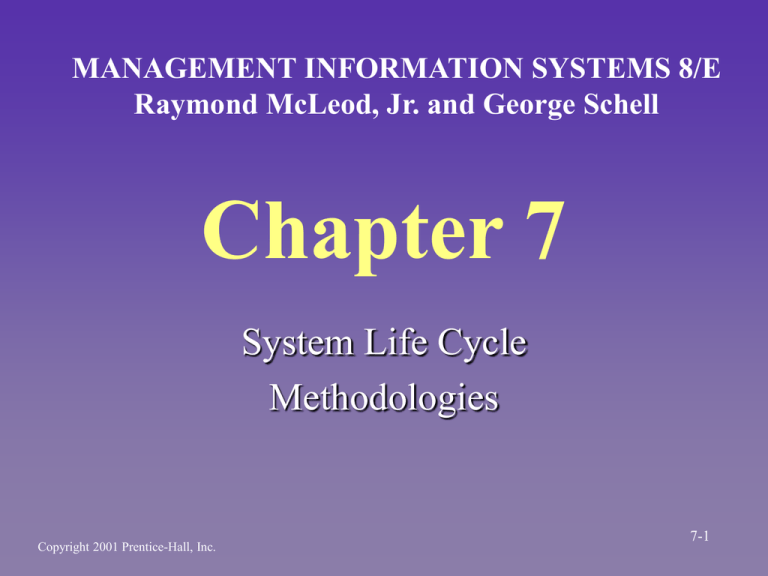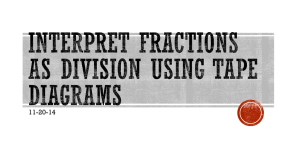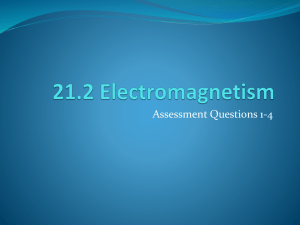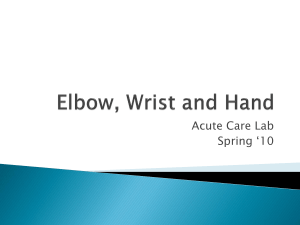Chapter 7
advertisement

MANAGEMENT INFORMATION SYSTEMS 8/E Raymond McLeod, Jr. and George Schell Chapter 7 System Life Cycle Methodologies Copyright 2001 Prentice-Hall, Inc. 7-1 The Systems Life Cycle (SLC) Methodology – Recommended way of doing something An application of the systems approach to the task of developing and using a computer-based system Often called waterfall approach 7-2 Phases in the SDLC 1) Planning 2) Analysis 3) Design 4) Implementation 5) Use 7-3 The System Development Life Cycle (SDLC) SDLC is the phrase that encompasses the planning, analysis, design, and implementation phases of the system life cycle Who participates – IS personnel – User – Information specialists can consult Traditional – Information specialists working with users. – A new strategy: Outsourcing 7-4 Life Cycle Management An upward migration Executive responsibility MIS steering committee – Functions » Set policy » Control the purse strings » Resolve conflicts 7-5 Managers of Systems Life Cycles are Arranged in a Hierarchy Executives MIS Steering Committee Marketing Manufacturing Finance Human Resources Project leader -Warehouse location model team Project leader MRP 11 team Project leader ISDN system team Project leader Credit approval system team Project leader HRIS team 7-6 Main Advantages of the Steering Committee Total firm support Projects will be characterized by good planning and control Establishes policies, provides fiscal control, and resolves conflicts Since the steering committee will probably not get involved with the details of the work, a project team is usually appointed. 7-7 Planning Phase Benefits – Define scope of the project – Spot potential problems – Arrange tasks in sequence – Provide basis for control 7-8 Steps 1. Recognize problem (the trigger) 2. Define problem 3. Set objectives 4. Identify constraints Recall that objectives, standards, and constraints are problem-solving elements. 7-9 Steps (cont.) 5.Conduct feasibility study (TENLOS) – – – – – – Technical Economic return Noneconomic return Legal and ethical Operational Schedule 7-10 Steps (cont.) 6.Prepare study project proposal – Goes to MIS steering committee 7.Approve or disapprove (go/no go) – Key questions? 1.Will the system accomplish its goals? 2.Is this the best way to go about it? 7-11 Steps (cont.) 8.Establish a control mechanism – Think in terms of: » 1. What » 2. Who » 3. When (Person-months versus calendar months) – PERT and CPM network diagrams 7-12 The Planning Phase MIS Steering Comm Manager 1. Systems Analyst Recognize the problem Define the problem 2. 3. 4. Set system objectives Consult Identify system constraints 5. 6. 7. 8. Conduct a feasibility study Prepare a system study proposal Approve or disapprove the study project Establish a control mechanism 7-13 Outline of a System Study Proposal 1. Executive summary 2. Introduction 3. System objectives and constraints 4. Possible system alternatives 5. The recommended system study project 5.1 Tasks to be performed 5.2 Human resource requirements 5.3 Schedule of work 5.4 Estimated cost 6. Expected impact of the system 6.1 Impact on the firm’s organization structure 6.2 Impact on the firm’s operations 6.3 Impact on the firms resources 7. General development plan (analysis, design, and implementation phase) 8. Summary 7-14 A Project Schedule Functional System: Subsystem: Model: Subtask Marketing Product Product Deletion Responsibility Time Estimate (Person Months) 1. Identify Systems analyst deletion criteria Product manager 0.75 2. Identify output information requirements 0.25 Systems analyst Network specialist Product manager 7-15 Project Schedule (cont.) 3. 4. 5. 6. 7. 8. Identify input data requirements Prepare new system documentation Design network Design database Review design Prepare program documentation Systems analyst DBA Systems analyst 0.50 Network specialist DBA Product manager Systems analyst Programmer 1.50 0.50 0.25 2.00 1.00 7-16 Project Schedule (cont.) 9. Code program 10. Test program 11. Approve program 12. Prepare database 13. Educate users 14. Cutover to model Programmer Programmer Operations staff Product manager VP of marketing DBA Systems analyst Operations staff 1.25 0.75 0.50 2.00 0.50 0.75 7-17 Analysis Phase Steps 1.Announce » Reasons for project » Purpose: inform and counteract fear 2.Organize project team » User(s) » Specialists » Define roles 7-18 Analysis Phase (cont.) 3. Define information needs » Methods Personal interview (the preferred method) Observation Record search (includes review of existing documentation) Surveys A project directory can be maintained as an encompassing set of documentation to describe the system 7-19 Analysis Phase (cont.) 4. Define system performance criteria 5. Prepare design proposal (Compare to system study proposal) 6. Approve or disapprove the design project 7-20 The Analysis Phase MIS Steering Committee 1. Manager Systems Analyst Announce the system study 2. Organize the project team 3. Define information needs 4. Define system performance criteria 5. 6. Approve or disapprove the design project Prepare design proposal 7-21 Outline of a Design Proposal 1. Executive summary 2. Introduction 3. Problem definition 4. System objectives and constraints 5. Performance criteria 6. Possible system alternatives 7. The recommended design project 7.1 Tasks to be performed 7.2 Human resource requirements 7.3 Schedule of work 7.4 Estimated cost 8. Expected impact of the system 8.1 Impact on the firm’s organization structure 8.2 Impact on the firm’s operations 8.3 Impact on the firms resources 9. General development plan (analysis, design, and implementation) 10. Summary 7-22 MIS Steering Committee Manager Systems Analyst 1. The Design Phase 2. 3. 4. 5. 6. Approve or disapprove the system implementation Prepare the detailed design system Identify alternate system configurations Evaluate system configurations Select the best configuration Prepare the implementation proposal 7-23 Design Phase 1.Prepare detailed design – Structured design (top down) » System level » Subsystem level – Documentation tools 2. Identify alternate system configurations – Refine to a manageable set 7-24 Popular Documentation Tools Data Modeling Entity-relationship diagram Data dictionary Screen/printer layout form Process Modeling System flowchart Program flowchart Data flow diagram Structured English Object Modeling Object relationship model Class specification 7-25 Data Flow Diagram of Four Data Processing Subsystems Sales orders Customers Rejected sales order notices Payments by customers Accepted orders 1.1 Order Entry Filled items Order log removals file 1.2 Inventory Invoices 1.4 Accounts Receivable 1.3 Billing Billed orders Inventory ledger data Purchasing data 2 Received items Receivables ledger data 3 2 7-26 3 Data Flow Diagram of Order Entry System Edit rejects Sales orders Sales order edit rejects Customer 1.1.1 Edit order data Rejected sales order notices Accepted orders 1.2 1.1.3 Log in orders Edited orders Customer credit file Edited and checked orders 1.1.2 Compute credit check Credit data Credit rejects Sales order credit rejects Order data 1.3 Completed orders 1.1.4 Mark filled orders Date filled Order log 7-27 Hardware Choices Make Possible Multiple System Configurations System Elements Input Order log Customer credit file Rejected orders file Accepted orders file Completed orders file Alternatives •CRT terminal •Hardcopy terminal •OCR •Magnetic tape •DASD •Magnetic tape •DASD •Magnetic tape •DASD •Magnetic tape •DASD •Magnetic tape •DASD Rejected orders notice •Printer •CRT terminal •Hardcopy terminal •Batch Processing •Online 7-28 Alternatives Selected for Detailed Study Alternative Input 1. 2. 3. Order Log Customer Credit File Scanner Magnetic tape Magnetic tape Keyboard terminal Magnetic tape Magnetic tape Keyboard terminal Magnetic tape Magnetic tape Accepted & Rejected Orders File Magnetic tape Magnetic tape Magnetic tape Completed Orders File Rejected Orders Notice Magnetic tape Printer Magnetic tape Magnetic tape Printer Hardcopy terminal 7-29 Design Phase (cont.) 3. Evaluate configurations 4. Select best configuration 5. Prepare implementation proposal 6. Approve or disapprove the system implementation 7-30 Outline of an Implementation Proposal 1. Executive summary 2. Introduction 3. Problem definition 4. System objectives and constraints 5. Performance criteria 6. System design 6.1 Summary description 6.2 Equipment configuration 7. The recommended implementation project 7.1 Tasks to be performed 7.2 Human resource requirements 7.3 Schedule of work 7.4 Estimated cost 8. Expected impact of the system 8.1 Impact on the firm’s organization structure 8.2 Impact on the firm’s operations 8.3 Impact on the firms resources 9. General implementation plan 10. Summary 7-31 Implementation Phase Acquire and integrate the physical and conceptual resources to produce a working system 7-32 Steps for the Implementation Phase 1. Plan implementation 2. Announce 3. Obtain hardware resources RFP / Written Proposals 4. Obtain software resources "Make or buy" 5. Prepare database 6. Prepare physical facilities 7. Educate participants and users 8. Prepare cutover proposal 9. Approve or disapprove cutover to new systsem 10. Cutover to new system 7-33 The Implementation Phase MIS Steering Committee Information Specialists Plan the implementation 1. 2. Manager Announce the implementation 3 Obtain the hardware resources 4 Obtain the software resources 5 Control Control 6 7 8. Prepare the database Prepare the physical facilities Educate the participants and users Cutover the new system 7-34 Outline of a Request for Proposal 1. Letter of transmittal 2. System objective and applicable constraints 3. System design 3.1 Summary description 3.2 Performance criteria 3.3 Equipment configuration 3.4 Summary system documentation 3.5 Estimated transaction volume 3.6 Estimated file size 4. Installation schedule 7-35 Outline of Supplier Proposal 1. Letter of transmittal 2. Summary of recommendations 3. Advantages 4. Equipment configuration 5. Equipment specifications 5.1 Performance data 5.2 Prices 6. Satisfaction and performance criteria 7. Delivery schedule 7-36 Cutover Approaches Pilot Old System Pilot System Immediate cutover Phased cutover Parallel cutover Immediate New System Old System Phased Old System New System Old System Parallel New system Time 7-37 Use Phase 1.Use 2.Audit (post implementation review) » By information specialist(s) » By internal auditor (a different one from the project team member) 3. Maintain the system » Correct errors » Keep current » Improve 4. Prepare reengineering proposal 5. Approve or disapprove reengineering 7-38 The Use Phase MIS Steering Committee Manager 2 1 Control 5 Information Specialists Use the system Audit the system 3 Maintain the system 4 Prepare reengineering proposal Approve or disapprove the reengineering proposal 7-39 Prototyping Type I -- Becomes operational system Type II -- Serves as a blueprint 7-40 Development of a Type I Prototype 1. Identify user needs 2. Develop a prototype N 3. Prototype acceptable? Y 4. Use the prototype 7-41 Identify user needs Development of a Type II Prototype Develop a prototype Y Prototype acceptable? N Code the operational system Test the operational system Y System acceptable? Use the operational system N 7-42 The Attraction of Prototyping Communications between the systems analyst and user are improved. The analyst can do a better job of determining the user’s needs. The user plays a more active role in system development. The information specialists and the user spend less time and effort in developing the system. Implementation is much easier because the user knows what to expect. 7-43 Potential Pitfalls of Prototyping The haste to deliver the prototype may produce shortcuts in problem definition, alternative evaluation, and documentation. The users may get so exited about the prototype that they have unrealistic expectations of the operational system. Type I prototypes might not be as efficient as systems coded in a programming language. The computer-human interface provided by certain prototyping tools may not reflect good design techniques. 7-44 Applications That Are Good Prospects for Prototyping High risk Considerable user interaction Large number of users A need for quick delivery An expected short use phase of the system An innovative system Unpredictable user behavior 7-45 Rapid Application Development (RAD) Information engineering (IE) Key ingredients – Management should be experimenters or early adapters – Specialized teams – Methodologies (RAD life cycle) – Tools (I-CASE, 4GLs) RAD and the SLC are applications of the systems approach Tools are mainly 4th generation languages and CASE tools 7-46 Strategic overview of the information needed to run an enterprise as efficiently as possible Data model Design of records used by specific procedures . Information strategy planning (ISP) Business area analysis (BAA) Rapid application development (RAD) Strategic overview of the functions and goals of an enterprise The process needed to operate the enterprise and how they interrelate Design of procedures for specific applications Rapid Application Development is an Integral Part of Information Engineering 7-47 Business Process Redesign (BPR) Often used to react to systems that can no longer function adequately in the current business environment of the firm (legacy systems fall into this category) Three techniques for business process redesign are 1) reverse engineering 2) restructuring 3) reengineering 7-48 Reverse Engineering Reverse Engineering Produces Documentation on Successively Higher Levels but Leaves the System Unchanged Planning Phase Reverse Reverse Reverse Reverse Engineering Engineering Engineering Engineering Analysis Phase Design Phase Implementation Phase 7-49 Restructuring Restructuring Planning Phase Restructuring Analysis Phase Design Phase Restructuring Restructuring Implementation Phase 7-50 Reengineering Reverse Engineering Reverse Engineering Forward Engineering Planning Phase Forward Engineering Analysis Phase Reverse Engineering Forward Engineering Design Phase Reverse Engineering Forward Engineering Implementation Phase 7-51 Selection of BPR Components Based upon functional quality – What the system does Based upon technical quality – How the system does its job The relationship between these two characteristics suggest which BPR technique would be appropriate 7-52 Selection of BPR Components Good Functional Quality (What?) Poor Reverse Engineer Restructure Do Nothing Forward Engineer Reengineer Poor Good Technical Quality (How?) 7-53 SLC, Prototyping, RAD, and BPR in Perspective SLC, prototyping, and RAD are all methodologies – Recommended ways of implementing a computer-based system BPR revamps systems that were implemented with computer technology that has become obsolete 7-54 Summary System Life Cycle – – – – – Planning Analysis Design Implementation Use Cycle management responsibility Other methodologies 7-55








